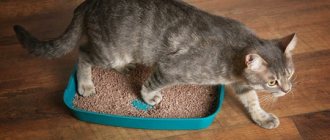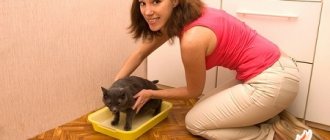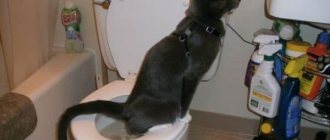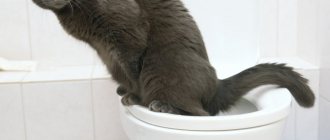Home » Useful Information
How to train a kitten to go to the litter box? Very simple!
You will need to set aside a little time, be patient and take into account the important advice of veterinarians.
The result will be achieved quickly if you simultaneously take into account the pet’s character and start the training process on time.
When a fluffy ball appears in the house, all family members are filled with a feeling of joy.
But immediately after a small puddle and other not-so-fragrant “traces of a crime” are discovered in one of the corners, euphoria gives way to disappointment, and sometimes even irritation.
And to prevent this from happening in the future, it is enough to know how to teach a kitten to go to the litter box. All it takes is a little patience, time and attention.
In fact, it's quite easy to instill good manners in him.
- 2 Tray selection
- 3 Space for tray
- 4 Training - basics
- 5 Express method
Timely training
It is advisable to accustom a kitten to the tray from an early age. From which one?
As soon as possible, ideally when he reaches four weeks.
Teaching a one-month-old kitten to order will be quite quick and easy.
According to the advice of veterinarians, this particular age limit is optimal for animals to learn new information and skills.
But this requires persistence on the part of the owner.
If the owner does not pay attention to the “dirty things” left in the corners of the apartment and silently removes them, then the pet will decide that this is in the order of things
Important! It is much more difficult to teach order to a two-month-old kitten, especially after he has been pooping wherever he wants for quite a long time!
If you took the baby from a nursery, where until now his mother was looking after him, then you should not flatter yourself with the hope that she instilled good behavior in him.
As a rule, cats do not train their kittens to use the litter box. Kids can simply copy her actions.
And even if small pets managed to adopt some good habits during the time spent next to her, there is a high probability that the skills will be lost when the situation changes.
Even if the cat mother set an exceptionally good example for the baby, separation from her can lead to a complete loss of this experience.
When a kitten turns one month old and is immediately separated from its mother, it experiences stress, no matter how friendly its new owners are to it.
The baby is lost and often does not control his natural urges.
Here, new owners should show restraint and teach the kitten to go to the litter box on their own.
How long will it take? It all depends on your persistence and the character of the baby.
How to become an authority for your pet
Cats understand human emotions well and know how to manipulate. Do not follow your pet's lead: the kitten must know that you are the leader in your territory. It is important to define rules of behavior and constantly follow them.
Cats do not live in packs and do not follow a leader. The main incentive for them is profit. Let the kitten understand: you are a source of affection, communication, treats - your rules should be followed. Otherwise, it won’t be long before you lose these pleasures.
Establish a good, trusting relationship with the animal. Pay attention not only to education and character formation. Your kitten needs to feel confident in your home. Provide him with a feeling of safety in communicating with people and a secluded place to relax. Remember to pay enough attention, but also respect personal space. A cat, like a person, periodically seeks to be alone.
Tray selection
Looking at a one-month-old kitten, many people think that it needs the smallest tray.
You can learn how to determine the age of a kitten from the article
But it is not so. Taking care of the baby in this case is quite understandable, but it should be remembered that the animal will grow quite quickly.
The weeks will fly by unnoticed: today the kitten is a month old, and after, it would seem, a couple of days he is already 1.5 months old, a little more and he has reached two months of age.
Before you even blink your eye, the furry baby will turn into a respectable cat that no longer fits in its toilet.
And if you are the happy owner of one of the large breeds , such as Maine Coon , Ragdoll or Savannah , then in this case the smallest toilet is out of the question.
If you rely on the advice of veterinarians, then you should immediately purchase a tray with sides of about 8-10 cm: the pet can easily overcome them, the main thing is that he wants to do it.
But the height should not be too high.
In any case, as the animal grows, you will have to change its litter box to a larger one once or twice.
And in order to accustom a kitten to the litter box fairly quickly, it is necessary that it meets the following requirements:
- complete absence of foreign odors;
- the material from which the toilet is made should not oxidize upon contact with feces;
- The tray should not rattle when the kitten tries to cover its “footprints”, otherwise it will scare it.
The baby should feel comfortable and safe
Thus, it turns out that the most suitable option is a plastic tray.
It may come complete with a grille or be without it.
What to buy is up to you, but here you need to take into account that a toilet with a grate is more convenient to use.
This way, liquid feces will pass through it, and your pet’s paws and fur will remain clean.
This aspect is especially relevant when your apartment contains a representative of one of the long-haired breeds, for example, a Persian , Siberian , or Norwegian cat .
How to stop aggression
The kitten is a predator; during play she tries to “hunt”. It is important to make it clear: claws and teeth cannot be used. The sooner you do this, the better. Bites and scratches from a baby do not cause much discomfort, but the claws of an adult cat can seriously injure. Never tease your kitten with your hands or feet. This provokes him to hunt them. If your pet bites or scratches, stop playing immediately. Speak to him in a stern, firm tone, but do not shout. When your pet arches its back, snorts, hisses, flattens its ears and wags its tail, it is angry and ready to fight. Distract attention with a loud, unexpected sound; in extreme cases, use a spray bottle of water. It is very important that the animal learns that aggression is not allowed.
Tray space
Since it is easier to accustom one-month-old kittens to a tray than two-month-old ones, this same tray should appear in your apartment at the same time as the small pet.
But the toilet must be in a certain place and you will have to choose the corner with special care.
By the way, at the same time it is recommended to start making a scratching post , which will help avoid troubles in the form of damaged furniture and wallpaper.
Each representative of the cat family is individual, with its own character and temperament.
And if in most cases it is possible to accustom a street kitten to a litter box quite quickly, since he is used to defiantly relieving himself, then with some people from elite nurseries it is not so simple.
For example, if you bought a Scottish or British kitten , then he may turn out to be very shy.
It will be possible to accustom him to the toilet only if it is located in some secluded place.
And sometimes you even have to purchase a closed toilet .
So, the most suitable place will meet the following conditions:
- silence - away from the refrigerator and other appliances that make noise during operation;
- not on the aisle, preferably in a corner - this could be a place under the bathroom or a corner in any room or corridor;
- The tray should always be freely accessible - not behind a closed door and not in the narrowest corner under the bathroom, where the kitten will not fit.
You need to spend as much time searching for a suitable place as the animal needs.
Otherwise, you may not be able to train your kitten to go to the litter box.
This article will tell you how to remove the smell of cat urine /
If he finds the angle you have chosen inconvenient, he will continue to shit all over the apartment.
How to teach not to spoil furniture
The kitten does not spoil the upholstery out of mischief. He definitely needs to sharpen his claws. This way he relaxes, practices the skills of releasing his claws and cleans them of dead tissue. Therefore, it is important to choose a scratching post that suits your pet. Vertical or horizontal, free-standing or mounted on furniture - it all depends on the preferences of the animal.
Help the kitten understand the purpose of the scratching post. To do this, carefully take his front paws and place them on its surface. If the kitten continues to tear furniture and wallpaper, use special pads to protect them. Bedspreads or temporarily closed doors to a room with a favorite item are also suitable for this. Use special sprays to scare away furniture and attract attention to the scratching post.
Training - Basics
If a kitten is only a month old, then at that age it is extremely rare to train it to go to a litter tray without litter .
Veterinarians advise starting the training process with a toilet, which will have something with which the animal can cover its excrement.
The filler can be either pressed wood shavings or mineral lumps of clay, or ordinary newspaper, torn into small fragments.
It is better, of course, to use a tray with a professional filler that can absorb unpleasant odors and liquid feces
Thus, you can quickly accustom any kitten to the tray, street, Scottish or British, it doesn’t matter, the main thing is that its paws and fur will always be clean and dry.
So, the baby is a month old or 1.5 months old, we purchased a tray, found a place for it, now we move directly to the main process.
- Place the tray with the filler in the selected location.
- We carefully lift the kitten and put it in the vessel.
- We take his paws in our hands and begin to make raking movements.
- Let's release the baby.
Don't expect him to do his business in the new toilet the first time.
It often takes several days, and sometimes a couple of weeks, to train one-month-old kittens to use the litter box.
At first, you need to watch your pet and try to catch his desire to go to the toilet.
When a kitten is 1.5 months old, before defecating, it may show some concern: the animal will seem somewhat alarmed, and may spin in place or rake its paws on the floor.
It is important here not to miss the moment when the kitten starts to shit.
Transfer the animal to the litter tray and wait for the baby to do its job
Important! According to the advice of veterinarians, in order to teach a kitten to go to the right place, it must be taken to the tray as often as possible - after each meal and immediately after waking up. This way you can quickly teach your pet good manners!
If an outdoor kitten appears in your apartment, then training it to a litter box will be much faster than, for example, an Egyptian Mau or a Burmese cat .
This is due to the fact that an animal that previously lived in street conditions is much more willing to respond to care and at the same time is very smart.
How long will it take in this case? Usually two or three days, no more.
The length of toilet training for your pet may depend on the quality of the litter.
At what age should a kitten be accustomed to a litter box without litter?
You can do this right away, but it is better after he gets used to his toilet and will always defecate exclusively in it.
To consolidate the result, the kitten needs not a month, but much more: about six months must pass for the animal to fully understand where its latrine is, and only after that can one begin to accustom the kitten to a toilet in which there will no longer be litter.
Which filler to take
Now you can find special gel fillers that instantly absorb all moisture.
Kittens like to be dry, so they willingly go about their business in their potty. If there is no special signature on the packages “For kittens,” it is better to choose a filler that is not too coarse. This way it will be more convenient for the little paw to bury “traces of crimes.”
At first, you need to make sure that the baby does not try the filler on the tooth. This often happens, the owner should stop this action.
If it is absolutely impossible to buy filler, then you can use sand or torn newspaper. True, in this case the pot will not rid the room of the unpleasant smell, even if you clean it almost immediately. Numerous practices have already proven that you should not skimp on filler. Many of them are very inexpensive, it is spent sparingly, and the air in the room remains fresh, there is no dirt on the floors (like after a pot of sand), and the cats themselves prefer special fillers.
How to train a kitten to use the toilet
There is nothing better than to cope with the task of training a cat to use the litter box. However, it’s even cooler to teach her to go to the toilet. You don't have to change the tray, clean it, or buy filler.
Getting your pet used to the toilet is a difficult process. At a young age, he is not able to climb to the height of the toilet on his own. If you plant it by force, you will achieve nothing but fear.
You can start the training period when the pet is 5 months old. This is done in several steps:
- The tray is taken to the toilet room and placed with the toilet.
- When the pet takes a closer look and begins to go to the tray in a new place without fear, it is time to gradually lift the container. It is recommended to place magazines (newspapers, unnecessary books) or other suitable material under it. The height of the container must be increased weekly so that the animal can settle in there.
- When the container eventually reaches the level of the toilet, start leaving it on top of the device overnight. Simply fold back the lid with the toilet seat and place the tray in the freed space. By that time, your pet should easily climb onto the raised potty.
- When the animal begins to relieve itself in the container on the toilet without fear, it is time for the next step.
- Hide the tray overnight and throw one or two handfuls of the litter into the open toilet. In the morning, the tray can be returned and left on a raised platform nearby.
At first, you only need to do this at night. If you notice that your cat is sitting on the toilet without fear, feel free to remove the potty.
For a cat, it is possible to select special toilet attachments. They are freely sold in pet stores. The device allows you to easily take it off when you go to the toilet, and then put it on again. It is recommended to initially pour a little filler into such a nozzle so that the pet can be identified by its smell. Plus, such a nozzle closes the water in the toilet, the noise of which can scare the cat.
Important! It will take 1-2 months and a lot of patience to train your pet. The most important thing is to do everything step by step, and not to scare the animal.
Advice. Accept the kitten as an equal member of your family if you brought it into the house. The fact is that animals subtly sense the emotions of people. They listen to a person the better, the more love they receive from him.
Useful tips on how to quickly train a kitten to fly
Tips to speed up the process of how to train a cat to fly:
- Buy special aerosols that discourage cats from wanting to dirty in a specific space. The product is easy to buy at a pet store.
- Apply it to those areas where the animal often shits, so that it learns to go to one place. Use large pots with real flowers (the presence of soil is important). They are attractive to cats because it is convenient to relieve themselves in the ground. If there are already such vases in the room, sprinkle the top layer of soil with crushed or small pebbles. This will not harm the plants, but it will certainly repel unwanted pests.
- Acetic acid or ammonia will help get rid of the smell of cat excrement.
- For a large house or apartment, it is better to get two or three pots at once. They need to be placed in different places, and the pet must be accustomed to each.
- Keep the container in order. The cat will not walk where there is a lot of dirt.
Try to follow useful tips. And then the question of why the kitten does not go to the tray and what to do will not concern you.
The process of training a kitten to the tray
After preparations, it’s time for the learning process. First, let the kitten get used to it a little and go ahead.
Stage one - getting to know each other
The method for training a kitten to use the tray begins with familiarization with the “place”. The animal should be carefully placed in the container and allowed to sniff it. The following action will help the animal to recognize the connection with the place on an instinctive level: you need to lift the kitten’s paw and let it dig.
Stage two - we observe and help
At first it is difficult for the kitten to decide where to defecate. Luckily, it’s easy to tell by his behavior when he’s about to relieve himself.
The first day will require strict observation of your pet. If you notice a kitten fussing, digging (including on the floor), meowing and circling, know: he is ready for “business.” Hurry up and put him in the tray and leave him there until he finishes.
The main thing is to avoid using force (pushing, hitting, poking the kitten’s nose into the litter) and harsh words. This attitude can cause fear. In the future, the tray will become associated with negativity in the pet, and he will be afraid to approach it.
If things worked out and the baby did what he was supposed to do, caress him and say a few kind words. A good attitude will easily accustom the animal to the tray. There is no point in removing feces right away: let the baby later find the right place based on its smell.
Stage three - fastening
Even if the task of teaching a cat to go to the litter box is successful, he is still capable of leaving a cute “surprise” in an unexpected place. And for this the pet deserves reproach, but not much. The “bunch” should be placed in the litter and the kitten should be left in the tray. Do the same with the puddle, first wiping it with a napkin.
Possible difficulties
The willful nature of a cat does not always make for good learning. Sometimes, even if all the conditions have been created for a little bully, he still continues to act out, which makes it difficult to tame him. Let's take a look at the most common situations.
The kitten ignores the litter box, how to train it?
The reasons why a kitten does not go to the litter box, even if the rules are followed, may be as follows:
- It’s unpleasant for him to be there;
- I didn’t like the filler;
- There are smells nearby that repel cats (they especially don’t like citrus scents).
Attention! There should not be an air freshener or other source of aromas that are pleasant to humans but not to cats near the toilet.
Sometimes an animal defecates in a place where small children have peed: on the carpet, bed or sofa. The reason for the incident is that the pet follows its instincts, relying on smells. Don't scold him. The way out is to thoroughly clean the “memorable” place so that the process of how to accustom a cat to the litter box ends successfully.
Sight malfunction
It also happens that the baby falls past the tray. There may be several reasons here:
- The container has high sides, which are difficult for children to climb over;
- he is still very small and does not understand spatial boundaries well;
- He didn’t like the filler, although he understands where the filler is and that he needs to walk in it.
Think about what reason you think is most likely. It may be better to replace the container and contents. Or wait until the baby grows up and begins to navigate his way around on his own.
Kitten in the house: where to start?
The task of how to accustom a kitten to the litter box consists of 3 stages:
- Select tray.
- Selection of filler.
- Choosing a “place”.
Let's get acquainted with all the stages in detail.
How to choose a tray
It is a mistake to think that a kitten needs a small tray. Kittens grow quite quickly.
It will be more convenient to purchase a container of regular sizes. The quality of the product depends on the strength of the plastic.
There are trays with and without grids. The grid prevents the pet from getting its paws wet due to the fact that it is attached to the top of the tray. There is a drawback here: the animal can easily get its paws caught on the rods of the device. According to the practice of “cat breeders,” it is better not to buy a grate, but to make do with a filler. The substance will immediately absorb moisture.
If you use a grill, the kitten may hurt its paws. How to accustom a small kitten to a litter tray does not depend on the shape of the latter. Containers can be square, oval or corner. A protective rim on top of the tray will prevent the pet from spilling the filler when the animal begins to clean up after itself.
Important! You need to purchase a tray before the kitten arrives in the family. Or on the day when the replenishment occurred.
Which filler should I take?
Fillers for cat litter are:
- clay;
- wood based;
- from grain and paper waste;
- silica gel;
- based on minerals.
Silica gel ones are considered the best, followed by wood ones, due to their excellent absorption of liquid and blocking of bad odors. “Cullets” made from paper and grain waste are considered good. Mineral and clay ones absorb moisture worse.
The question of how to accustom a kitten to a litter box in an apartment can be solved more easily with a filled container. The smell of waste remains in it, and the baby navigates it. Flavored fillers can “overwhelm” the smell, and you shouldn’t buy them.
Where to put the tray to quickly train a kitten?
The choice of place for the pot is determined by 2 nuances:
- Free access of the animal to the tray.
- The tray should be located away from the place where the pet eats.
The best option is to place the pot in a room with tightly closing doors. The baby will not be able to open them and will do his job wherever he has to. At first, nothing should interfere with his journey to the toilet room. It is also necessary that nothing distracts the kpoxy during the “important task”. It is not recommended to move the pot to another place, this will complicate access to it.
Does age matter?
A kitten is just like a child. Like any baby, he learns everything from his mother. Any cat mother knows how to train a kitten to go to the litter box. However, if he grows up without her, this responsibility falls on the shoulders of the owners.
3. Age matters. It is best to adopt a kitten when it is already 3 months old, it is easier to train it. By this time, he already understands the order of things around him, and is ready to listen to everyone he considers leaders. At the same time, gender is not important: both the kitty and the cat will quickly get everything if you follow the rules.











